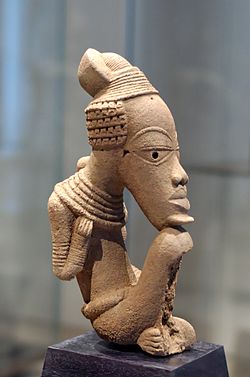Saylor.org's Ancient Civilizations of the World/Western and Central Africa
African History
Antiquity
[edit | edit source]West Africa
[edit | edit source]
In the western Sahel, the rise of settled communities was largely the result of domestication of millet and sorghum. Archaeology points to sizable urban populations in West Africa beginning in the 2nd millennium BCE. Symbiotic trade relations developed before the trans-Saharan trade, in response to the opportunities afforded by north-south diversity in ecosystems across deserts, grasslands, and forests. The agriculturists received salt from the desert nomads. The desert nomads acquired meat and other foods from pastoralists and farmers of the grasslands and from fishermen on the Niger River. The forest dwellers provided furs and meat.
Tichit (Dhar Tichitt) and Oualata were prominent among the early urban centers, dated to 2000 BCE, in present day Mauritania. About 500 stone settlements litter the region in the former savannah of the Sahara. Its inhabitants fished and grew millet. It has been found that the Soninke of the Mandé peoples were responsible for constructing such settlements. Around 300 BCE, the region became more desiccated and the settlements began to decline, most likely relocating to Koumbi Saleh. From the type of architecture and pottery, it is believed that Tichit was related to the subsequent Ghana Empire. Old Jenne (Djenne) began to be settled around 300 BCE, producing iron and with sizable population, evidenced in crowded cemeteries. Living structures were made of sun-dried mud. By 250 BCE, Jenne was a large, thriving market town.
Farther south, in central Nigeria, around 1000 BCE, the Nok culture developed on the Jos Plateau. It was a highly centralized community. The Nok people produced miniature lifelike representations in terracotta, including human heads, elephants, and other animals. By 500 BCE, they were smelting iron. By 200 CE, the Nok culture had vanished. Based on stylistic similarities with Nok terracottas, the bronze figurines of Ife and Benin are believed to be continuation of the tradition.
Central Africa
[edit | edit source]
The Bantu expansion was a critical movement of people in African history and the settling of the continent. People speaking Bantu languages (a branch of the Niger–Congo family) began in the second millennium BCE to spread from Cameroon eastward to the Great Lakes region. In the first millennium BCE, Bantu languages spread from the Great Lakes to southern and east Africa. An early expansion was south to the upper Zambezi valley in the 2nd century BCE. Then, Bantu speakers pushed westward to the savannahs of present-day Angola and eastward into Malawi, Zambia, and Zimbabwe in the 1st century CE. The second thrust from the Great Lakes was eastward, 2,000 years ago, expanding to the Indian Ocean coast, Kenya and Tanzania. The eastern group eventually met the southern migrants from the Great Lakes in Malawi, Zambia, and Zimbabwe. Both groups continued southward, with eastern groups continuing to Mozambique and reaching Maputo in the 2nd century CE, and expanding as far as Durban. By the later first millennium CE, the expansion had reached the Great Kei River of South Africa. Sorghum, a major Bantu crop, could not thrive under the winter rainfall of Namibia and the western Cape. Khoisan people inhabited the remaining parts of southern Africa.
Attribution
[edit | edit source]"History of Africa: West of Africa" (Wikipedia) http://en.wikipedia.org/wiki/History_of_Africa#West_Africa
